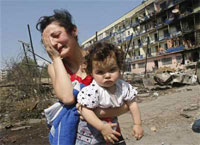Georgia and the West Still Wage Informational War Against Russia
It has been a year since the beginning of the war between Georgia and South Ossetia, which Georgia, a republic of the former Soviet Union unleashed on August 8, 2008 (08.08.08, or just 888). Tskhinval, which suffered from the Georgian aggression most, continues to return to normal life as the capital of an independent state. However, even if there is no military action in the region, the war in the Northern Caucasus continues. This is a different kind of war – the informational war – which never stopped during these 12 months.

Georgia attacked South Ossetia at night of August 8. Russian news agencies reported at 9:30 a.m. that Georgia’s Grad volley-fire systems shelled the headquarters of Russian peacemakers and destroyed peacemakers’ barracks. It was later reported that several Russian servicemen were killed in the attacks.
It was subsequently revealed as a result of the investigation of the Georgian aggression that the Georgian military had left the peacemaking headquarters prior to the beginning of the aggression. International observers, including those of the OSCE, disappeared too. Moscow was not informed about it in the morning of August 8 – the situation was unclear.
The doubts were dispelled in the afternoon of August 8. Russian troops entered South Ossetia in response to Georgia’s attacks. Georgia’s President Mikhail Saakashvili stated, though, that it was Russia that launched the military attack against Georgian towns. Joseph Biden, the chairman of the US Senate Committee on Foreign Relations, supported Saakashvili immediately and urged South Ossetia and Russian peacemakers to end the military action.
The Western media concentrated their attention on Georgia, which, as they said, was the victim of Russia’s attacks against the nation. Most of those reports were based on the notorious TV footage, which was supposedly filmed in the Georgian town of Gori. The dead bodies, which were shown in that report, seemed to be identical to one another in spite of the fact that the footage was made in different parts of the town.
Sky News launched another fabrication soon afterwards as it aired a report from Gori showing demolished buildings and bomb explosions. It was later revealed, though, that it was Russian TV Company Zvezda that filmed the report. Moreover, the footage was made not in Georgia’s Gori, but in South Ossetia’s Tskhinval.
The war clearly showed that the “free” Western media were used as an instrument of the anti-Russian propaganda. The entire conflict between Georgia and South Ossetia was represented as Russia’s attack against Georgia. Unfortunately, there are enough forces and movements in Russia that seem to be ready to accept and follow the point of view of Western partners.
The informational war against Russia continues today. A Polish journalist said recently that he was fired for his reports from South Ossetia.
The journalist said that he intended to cover the events in South Ossetia from different points of view. “I did not want to take Mikahil Saakashvili’s side, like many of our media did. As soon as the news about Georgia’s attack against Tskhinval surfaced, I went on the air and said that it was a war crime to fire missiles at the sleeping city at night. Warsaw did not like it. In Poland, the conflict was covered from a completely different position,” journalist Wiktor Bater said.
Georgia continues to insist on the version of Russia’s attack against the nation. Georgian officials exposed new information to “prove” that Georgian tanks entered the territory of South Ossetia in response to Russia’s aggression. The European Union persistently emphasizes Georgia’s territorial integrity.
The ‘hot war’ ended in the Northern Caucasus a year ago, but the informational war continues.
Ivan Milovanov
Pravda.Ru
Also read: Putin: Georgia could have maintained its territorial integrity
Subscribe to Pravda.Ru Telegram channel, Facebook, RSS!


